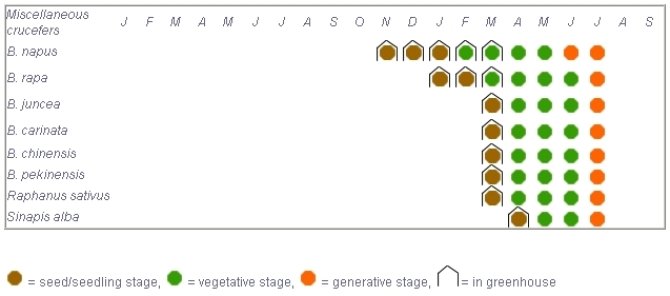
Regeneration of miscellaneous crucifers
Seed dormancy
None.Vernalization
Vernalization of B. napus and B. rapa occurs in unheated greenhouses during the winter in the seedling stage. Springtypes of B. napus and B. rapa, horticultural B. rapa, B. carinata, B. juncea, Sinapis alba and Raphanus sativus do not need vernalization.Crop phenology

Sowing and planting
All crucifers that do not belong to the cole crops are sown in boxes and later are transplanted in peatpots. In April the pots are planted in field plots, spatially isolated in winter rye or Triticale. The isolation plots are 50 m apart. Planting distance is 40 x 40 cm for all crucifers. About 50-100 plants are used to regenerate an accession.
Sowing and planting dates of miscellaneous crucifers
| Species | sowing date | vernalization |
|---|---|---|
| Brassica napus | November | 2 - 3 months in wintertime under non-heated greenhouse conditions |
| B. rapa | January | 1 - 2 months in wintertime under non-heated greenhouse conditions |
| B. juncea | March | - |
| B. carinata | March | - |
| B. rapa carinata | March | - |
| B. rapa chinensis | March | - |
| B. pekinensis | March | - |
| Raphanus sativus | March | - |
| Sinapis alba | Ap[ril | - |
Harvesting
Harvesting is carried out manually in July or August. Normally, accessions are harvested only once, but accessions with irregular ripening are harvested several times. The accessions are harvested in bulk and placed in bags together with the filednumber and pre dried on a drying floor.
Pest and disease control
Preventive:
- Cabbage fly (Delia brassicea)
- Additional protection against birds, rabbits and other wildlife is provided by netting.
- Rapeseed beetle (Meligethes aeneus)
- Cabbageseed weevil (Ceuthorrhynchus assimilis)
- Aphids
- Slugs